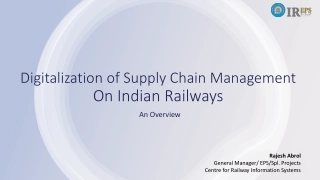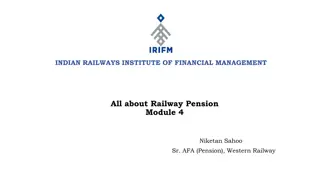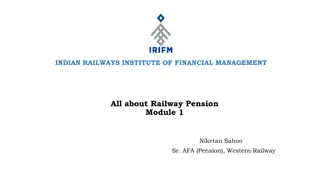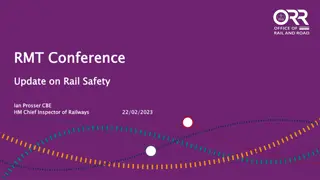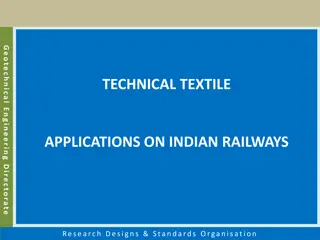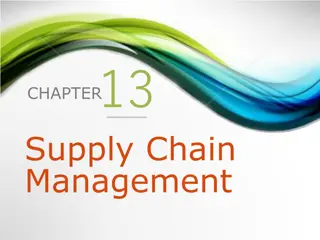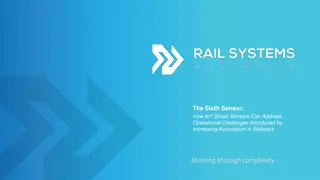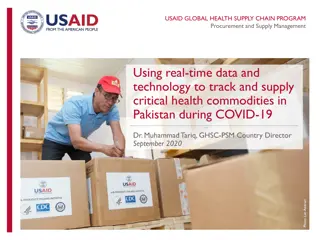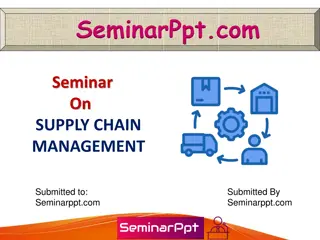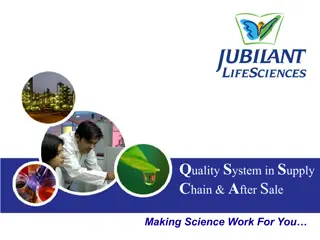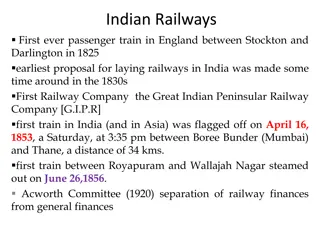Digitalization of Supply Chain Management on Indian Railways: An Overview
The digitalization of supply chain management on Indian Railways is being spearheaded by CRIS, the IT arm of the Indian Railways. Through the Indian Railways E-Procurement System, various critical applications are being utilized to enhance efficiency and transparency in procurement processes. The IREPS portal offers features such as E-Tendering, E-Reverse Auction, and procurement of goods, services, and works. Significant progress has been made over the years with a high volume of auctions, tenders, and decision making. Salient features include digitized item directories, digital encryption, and SMS/email alerts for various stages of the procurement process
Download Presentation

Please find below an Image/Link to download the presentation.
The content on the website is provided AS IS for your information and personal use only. It may not be sold, licensed, or shared on other websites without obtaining consent from the author.If you encounter any issues during the download, it is possible that the publisher has removed the file from their server.
You are allowed to download the files provided on this website for personal or commercial use, subject to the condition that they are used lawfully. All files are the property of their respective owners.
The content on the website is provided AS IS for your information and personal use only. It may not be sold, licensed, or shared on other websites without obtaining consent from the author.
E N D
Presentation Transcript
Lecturer: Dr. Perpetua S. Dadzie, Dept. of Information Studies Contact Information: psdadzie@ug.edu.gh College of Education School of Continuing and Distance Education 2014/2015 2016/2017
Session Overview At the end of the session, the student will be able to: Explain key concepts in information storage Describe usefulness of storage of print materials Explain usefulness of storage of electronic materials Slide 2 Dr. Perpetua Dadzie, Dept of Information Studies
Session Outline The key topics to be covered in the session are as follows: Topic One - Concepts in information storage and retrieval Topic Two - Storage of Print Materials Topic Three Storage of Electronic Materials Slide 3 Dr. Perpetua Dadzie, Dept of Information Studies
Reading List Slide 4 Dr. Perpetua Dadzie, Dept of Information Studies
Topic One KEY CONCEPTS IN INFORMATION STORAGE AND RETRIEVAL Slide 5 Dr. Perpetua Dadzie, Dept of Information Studies
Concepts in Information storage and retrieval (ISR) ISR - Systematic process of collecting and cataloguing data so that they can be located and displayed on request. Definition reflects manual information storage and retrieval ISR- operations performed by hardware and software used in indexing and storing file of machine-readable records whenever user queries system for information relevant to specific topic. Definition reflects computer- based ISR
Concepts in Information storage and retrieval (ISR) (2) ISR process, methods and procedures used to selectively recall recorded information from file of data. Definition reflects computer- based ISR ISR - Practised in archives, documentation centres, libraries, museums, records centres Originally ISR meant for text materials, eg books, newspapers, journals etc Modern ISR deals with multimedia, eg text, audio, images
Key components of ISR People Activities Equipment ISR manual and computerized Manual conventional tools such as bibliographies, catalogues, indexes, abstracting publications, thesaurus, directories Computerized Document retrieval; Database; Reference retrieval systems
Key components of ISR (2) Manual tools Bibliographies lists of books and other documents Catalogues bibliographies which list and record books and other library materials in a particular library. Materials arranged according to recognized scheme and systematic order containing bibliographic information. Scheme referred to as classification scheme. Popular schemes : Library of Congress, Dewey Decimal Classification, Universal Decimal Classification
Key components of ISR (3) Library of Congress alphanumeric, knowledge divided into 26 divisions Dewey Decimal Classification numeric (000 999) Universal Decimal Classification Index series of access points which lead from information known to user to additional previously unknown information Abstract concise and accurate representation of contents of a documents
Key components of ISR (4) Thesaurus work that contains synonyms and sometimes antonyms Designed for information retrieval; type of controlled vocabulary for indexing or tagging purposes Information retrieval thesauri formally organized so that existing relationships between concepts made explicit Directory list of persons or organizations systematically arranged usually in alphabetical or classified order giving addresses, affiliations, for individuals, and address, officers, functions and similar data for organizations
Key components of ISR (5) Today, all manual tools available in machine-readable format. Online catalogues (OPAC), bibliographic and non bibliographic databases.
Key components of ISR (6) Computerized tools Document retrieval systems store entire documents; information retrieved by title or keywords; full text searching permitted enabling retrieval of any words in document Database systems store information as series of discrete records that are divided into discrete fields (name, address and phone number) Records searched and retrieved on basis of content of fields (all people having particular telephone area code)
Key components of ISR (7) Computerized tools . Reference retrieval systems store references to documents rather than documents themselves Provide titles of relevant documents; efficient when large amounts of different types of printed data must be stored
Functions of ISR Identify information (sources) relevant to areas of interest of target users community analyse contents of sources (documents) Represent contents of analyzed sources in a way that will be suitable for matching users queries analyze users queries and represent them in form that will be suitable for matching with database Match search statement with stored database Retrieve information that is relevant and make necessary adjustments in system based on feedback from users.
Topic Two STORAGE OF PRINT MATERIALS Slide 16 Dr. Perpetua Dadzie, Dept of Information Studies
Storage of Print Materials Storage of print materials such as books, journals, magazines, documents, records, encyclopedias etc. have been done in institutions of Information Management. In libraries, materials stored in open and closed shelves. Open shelves /open access materials arranged for easy retrieval; materials available for immediate use; group or individual instruction required for layout and use of materials; basic finding aids must be provided;
Storage of Print Materials (2) Open shelves/access .. Classification scheme, card catalogue, periodical indexes for control of collection must be provided Open access useful for both library management and users Cheaper to operate; respects privacy of users; encourages browsing
Storage of Print Materials (3) Closed shelves/access Librarian acts as intermediary between collection and user Purpose of closed access - to protect materials by virtue of its condition, format, value, subject, content or illustration To prevent materials from being damaged, mutilated stolen on open access. High demand books and special collections kept in closed access. User does not require instruction on layout and use. More expensive to operate closed access; need for personnel at all times
Storage of Print Materials (4) In Archives Specialized equipment to protect, preserve variety of paper records such as: correspondence (letters, memorandums, notes); publications (magazines, newsletters) miscellaneous (reports, legal papers, maps, blueprints, forms) Commonly used containers for paper files vertical file cabinets, open shelf files, lateral filing equipment, mobile aisle systems, rotating shelves
Storage of Print Materials (5) In Archives Vertical file cabinets also called standard filing cabinets for storing letter-size papers. Have drawers that range from one to five Open shelf files for storage of records on open shelves rather than in closed drawers. Folders place vertically on fixed or adjustable shelves and arranged in rows with tabs to the outside for easy reading Lateral filing equipment form of open shelf filing units. Designed to have drawers, boxes, roll-out cradles or shelves, doors Mobile aisle systems set of file shelves moved manually or by motor on carriage that is imbedded in floor or contained within special platform
Storage of Print Materials (6) In Archives Slant files row of several stacked units anchored to wall with two other rows on heavy duty ball-bearing wheel carriages Rotating shelves contain two file units back to back with shelves inside closed container. To gain access to stored materials, unit is turned around. Types of files include: file boxes, bellow files, tub files, pigeon-hole files, drawer files (vertical file cabinets, lateral file cabinets, card cabinets, special cabinets); Open shelf units, rotary units (carousel units, wheel units), box storage files, horizontal files, tray files
Topic Three STORAGE OF ELECTRONIC MATERIALS Slide 23 Dr. Perpetua Dadzie, Dept of Information Studies
Storage of Electronic materials Electronic storage Utilizes electronics or electromechanical energy . Ex. Video and audio recordings, multimedia presentations, CD- ROM/DVD, online content CD ROM optical disk capable of storing large amounts of data. Stores around 680MB of data; data may be in text form, graphics, photographic images, video clips or sound files. Primary and Secondary Storage on Computer Information stored on RAM and ROM RAM Random Access Memory; computer s main memory is primary storage. Primary storage volatile; that is, when computer switched off, all content lost
Storage of Electronic materials (2) Electronic storage . ROM Read Only Memory - More permanent, non- volatile storage also known as secondary storage . Ex. Magnetic tapes, CD ROM, Microfilm Databases collection of data for example, list of names and addresses, details of customers, products, orders and payments in a large organization. Database now refers to data held on computer but non-computerized databases also exist. Difference between computerized and non-computerized databases - speed with which data can be accessed. Information can now be gathered in a few seconds.
Storage of Electronic materials (3) Electronic storage . Databases management systems software used to access, update and manipulate data in computerized database (DBMS) many different ways data can be organized in database but most common is relational database model. Microsoft Access example of relational database management system (RDBMS). Microfiche - Computer output on microfilm (COM) devices used to prepare microfiche. COM extensively used for archiving material such as old cheques or income tax returns.
Storage of Electronic materials (4) Electronic storage . Flat files - database held in single file which allows very simple structuring of data software that accesses and updates data commonly called file management system. File management differs from DBMS; data stored in one file cannot easily be linked to data stored in another file; flat-files useful for storing and retrieving data such as list of content names and addresses, list of student grades or details of a video collection Spreadsheet can be used as flat-file database, with a column representing a field and a row representing a record.
Video Storage devices <iframe width="560" height="315" src="https://www.youtube.com/embed/hdfIbNC4- NM" frameborder="0" allowfullscreen></iframe>


